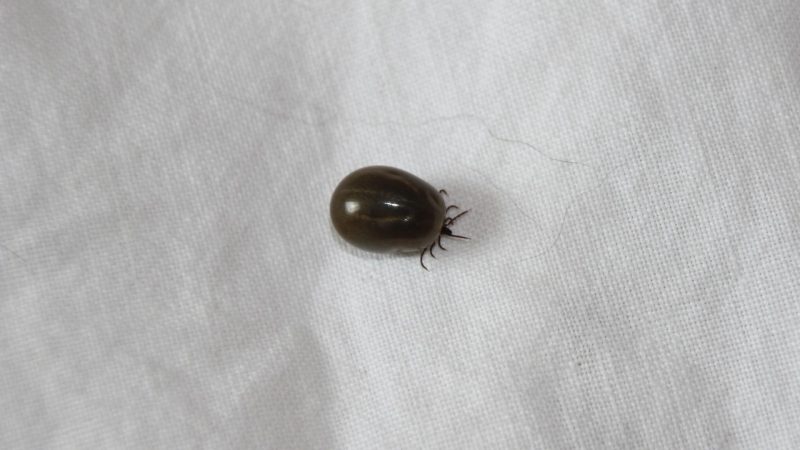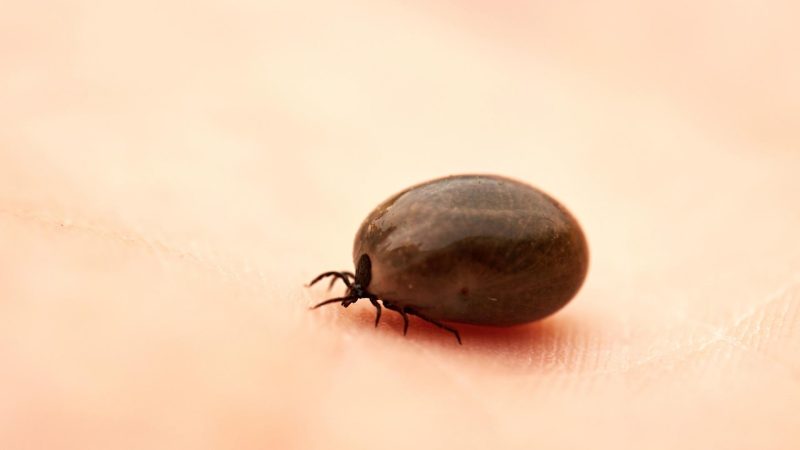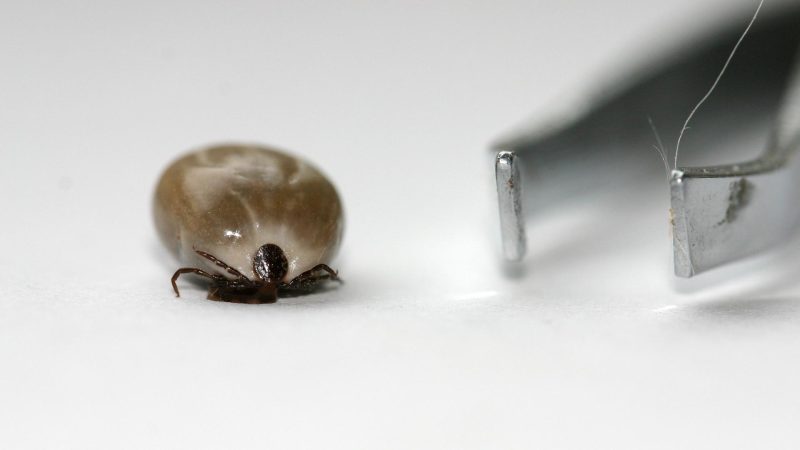Ticks cause blood-borne diseases such as Lyme disease, Powassan virus, Babesiosis, and Anaplasmosis. It’s best to watch out for them all the time since they can be either active in spring, summer, or fall.
This behavior depends on the species and the region where they reside. How about during winter? Some may think that these insects lie low in the freezing season.
Are ticks still active in the winter? Ticks are still active in the winter when the temperature is about 45 degrees Fahrenheit. They can survive the cold season in different ways. For example, they can latch on to a host for the necessary warmth. Some choose to hide under leaf litter that covers the bushy and wooded areas where they can reproduce.
How can small creatures like ticks survive the harsh winter? It’s unbelievable, but it’s true. The facts on how they deal with the freezing weather in this article will surely convince you. So, read on!
What Happens to Tick in Winter?

Ticks have already adapted and survived the Northern climate for thousands of years. Due to the physiological and biological adaptations, they can’t only live under freezing temperatures but the summer heat as well.
A few ticks may die in extremely cold weather, but it doesn’t lead to their extinction. Based on the data of the Pennsylvania Department of Conservation and Natural Resources, around 20% of the tick population perishes during winter.
Are Ticks Dangerous in Winter?
Ticks are still dangerous in winter. They’re not a big threat to human health though as they mainly harm wildlife, specifically the moose, which can be a host to 100,000 winter ticks.
They also stick to other animals like caribou, deer, elk, cattle, and horses. There are incidental hosts too, like dogs, coyotes, black bears, and beavers.
Winter ticks rarely bite and feed on humans. However heavy infestation takes place and comes with serious consequences such as hair loss, severe anemia, and skin irritation. The worst scenario caused by heavy infestation is death.
Can a Tick Live in Cold Weather?

A tick can live in cold weather. In controlled laboratories, ticks died at minus two to fourteen degrees Fahrenheit.
These findings are based on the research of Joyce Sakamoto of the Pennsylvania State University with consideration of the natural environment factors. For instance, ticks are not constantly exposed to the temperature that can kill them right away.
Does Frost or Snow Kill Ticks?
The frost or snow doesn’t directly kill ticks. It’s the exposure to a temperature that is below 10 degrees Fahrenheit that goes on for several days.
They’re just inactive when on frozen ground or blocks of ice. Just a bit of warmth can make them active again.
How Do Ticks Survive Winter?
Ticks are small but resilient creatures, so they have many ways to survive winter.
They keep themselves warm by adhering to the body of the host. Some ticks choose to be dormant and live underground. A study has discovered that ticks developed an antifreeze glycoprotein gene that allows them to survive the cold winter.
Where Do Ticks Go in Winter?
They hide under leaf litter that is usually in wooded and brushy places where they produce offspring. Some are covered by some debris, and they obtain insulation after the snowfall. Soft-shell ones reside in dens and burrows.
Do Ticks Die in the Winter?
Even if buried deep in the soil layer, roughly 1/5 of the local tick population will probably perish if the temperature drops to below 10 degrees Fahrenheit and remains within it for several days. But because they are especially hardy, female ticks can endure such chilly conditions until spring, when they deposit their eggs.
During the winter, severe temperature swings might lead to the death of some ticks. The tick cannot crawl back beneath for heat if the warm climate is followed by a severe cold spell that swiftly freezes the earth. Ticks will die if they are left outside in the cold.
How Did My Dog Get a Tick in Winter?

Blacklegged ticks are hardy during winter, and they’re found on the West Coast of the US. In the southern part of the country, brown dog ticks are active in the cold season.
Winter in some places is still warm enough for ticks to remain active.
If you live in a zone with a mild climate, ticks can’t be dormant, and your dog can be at risk of infestation all year round. In cold places, they creep under homes, barns, or animal dens. They become active once a mild day comes.
Beware of ticks when traveling with your dog in winter. Don’t dismiss the possibility of infestation when you go to a region where ticks are active throughout the year.
What Temperature Do Ticks Become Inactive?
Ticks start to become inactive at 35 degrees temperature, which usually occurs when there’s snow on the ground.
What Time of Year Do Ticks Go Away?
Ticks go away when the temperature drops during the fall season. However, it doesn’t happen in areas with moderate climates as they are active all year round.
When Do Ticks Come Out in Spring?
Ticks will restart activities and start looking for a host as soon as there is a period of two or three days with temperatures of 45 degrees or above. Since mosquitoes prefer days with a temperature of at least 50 degrees before returning for the season, ticks may reappear a little earlier.
Similar to mosquitoes, ticks prefer damp, sticky conditions and are most active and numerous during the hot summer months.
How Can I Prevent Getting Bitten by a Tick in the Winter?

Here are some things that you can do to prevent getting bitten by a tick in the winter:
- Wear clothes with tick repellent or treated with permethrin . In this matter, you have to be meticulous with your pants. It’s also smart to wear light-colored clothes, so you can easily spot ticks.
- It’s best to tuck in your shirt and pants in your socks.
- Spray insect repellent like Sawyer Products Insect Repellent and OFF! Deep Woods Bug Spray on boots, clothes, and gear when camping.
- Stay in the middle of the path when trekking or walking outdoors. Ticks don’t jump or fly, so you’ll only get contact with them when you get into their habitats which are shaded or wooded areas, shrubs, and low-lying plants,
- Every time you finish outdoor work or play, take some time to tick-check and try to find the adult ones. Check your legs, head, and armpits. To be sure, take a shower when you’ve been to places that have ticks.
- Before washing your clothes, let them stay in a hot dryer for around five to ten minutes. It’s a way to kill ticks that have clung to your clothes.
- Continue monitoring your pets for ticks as you can’t tell when the ice thaws. If it happens, ticks are on the move, so it’s just right to be watchful.
What Will Make a Tick Back Out?

You’ll need a pair of tweezers to make a tick back out. Here are the things that you need to do:
- Take out the tick with tweezers in the closest-to-skin manner.
- Don’t twist the tick so you won’t cut its body. Apply even pressure and steadily pull it upwards.
- Discard the live tick by putting it in a sealed bag. Wrap the bag with tape before flushing it in the toilet.
Never follow the myth of getting rid of ticks like putting them in Vaseline or nail polish and freezing them. These methods can do more harm as it will be difficult to hold the small creature when it’s slippery.
What Can Kill Ticks Instantly?
Three substances can kill ticks instantly, and they are as follows:
Bleach is a powerful substance as it can remove stains on clothes. Therefore, there’s no doubt that it can kill a tick. Put a reasonable amount of bleach in a container where you will let the ticks perish.
Eucalyptus Oil
Eucalyptus is both a repellent and a tick killer. Apart from being effective, it’s also safe on the body. You’ll need to mix twenty drops of this oil with four ounces of distilled or purified water.
After making the mixture, you can spray it on your body and pet. Doing so will free you from worries after you spend some time in the woods.
Rubbing Alcohol
Alcohol is not only a disinfectant but an effective tick killer. When you remove a tick on your skin or pet, you can put it in a bottle with alcohol and cover it so it won’t escape. Alcohol doesn’t need much time to kill it.
How Do I Get Rid of Ticks in My House Naturally?
1. Vacuum every corner of your home as well as carpet, chairs, window frames, and doors.
2. You may also make mixtures from natural ingredients. Here are some formulas:
- 2 to 3 lemons with a little water
- A combination of apple cider and water
- Boil chamomile in water and let it cool
- 1 tbsp. jojoba or almond oil, 6 drops of tea tree essential oil, 6 drops of peppermint essential oil, and 9 drops of citronella essential oil
Once you’re done with any of these mixtures, you can spray them around your house.
Related: How To Get Rid of Ticks in Yard | A Complete Guide
List of Sources
Neelakanta, G., et al. (2010). Anaplasma phagocytophilum induces Ixodes scapularis ticks to express an antifreeze glycoprotein gene that enhances their survival in the cold. The Journal of Clinical Investigation.
Winter Tick Activity. The University of Rhode Island.
Winter Tick or Moose Tick. The University of Maine.
- How to Get Rid of Cockroaches? | Proven Strategies & Solutions! - June 24, 2023
- Powerful Homemade Wasp and Bee Sprays (with Recipes) - March 4, 2023
- Crazy Ants Invasion | Eradicate & Prevent Unwanted Guests - February 24, 2023
